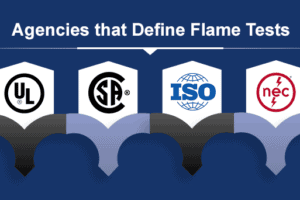Industrial wire and cable are often used in equipment installed in harsh application areas like oil and gas platforms, military vehicles, manufacturing equipment, etc. In such applications, there are possibility of fires breaking out. Fire is one of the greatest dangers that can damage and destroy industrial wire and cable. To ensure that the wires and cables are protected, manufacturers design the product with flame retardant materials. They also subject the cable through different types of flammability tests. We will elaborate about these tests in this post.
Agencies that Define Flame Tests
Agencies like UL, CSA, ISO, and NEC define tests within their respective standards to determine a cable’s flame resistance capability. All these agencies consider the following aspects for flammability tests:
- Flame Propagation
- Smoke Generation and Propagation
- Additional Support for Combustion
The NEC focuses on fire hazards in buildings, while UL and CSA focuses on application requirements.

Brief Descriptions of UL and CSA Flammability Tests
As most customers look at cable assemblies for applications, we shall be focusing on UL and CSA flammability tests. These tests are divided into small and large scale flame tests.
UL Flammability Tests: These are divided into one small, and two large scale flame tests.
- UL 1061: This is a small scale, vertical flame test. Cable that carry currents up to 500 Watts are subjected to this test. The UL 1061 is mainly used appliance wiring.
- UL Vertical Tray: This test is performed to check flame resistance of power and communication cables used in trays. The test is similar to the CSA FT4 flammability test, but not as stringent.
- UL 1666: This is also called a Riser Cable test. It is performed on cables that are used in vertical runs in a shaft. Like the UL vertical tray, the test is similar to the CSA FT4 flammability test, but not as stringent.
CSA Flammability Tests: These are divided into two small, and one large scale flame tests. FT1 and 2 are the small scale tests.
- FT1: This is a vertical flame test that should only be performed on manufactured cables. The FT1 is mainly used to test industrial equipment wire or Appliance Wire Material (AWM) with 500W.
- FT2: This is a horizontal flame test that is performed on finished cables. It is a minimum and mandatory requirement for flame testing flexible cords.
- FT4: The FT4 test is designed to test cables, which are going to be installed and used in tray and shaft applications.
Apart from the above mentioned tests, there is a test that is defined by both organizations – VW-1. This is also a vertical flame test, but is performed on flexible cords, as well as finished cables with 500 W.
These are the most important cable flammability tests that you should focus on when manufacturing industrial wire and cable. Discuss your application requirements with the cable manufacturer. Accordingly, he can suggest the appropriate test. A well tested cable can provide great performance in an application for many years.



